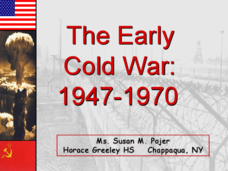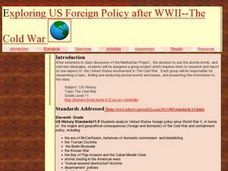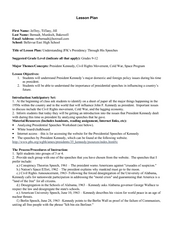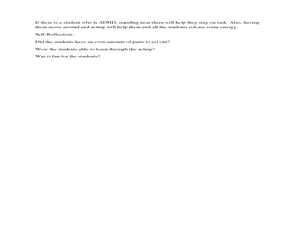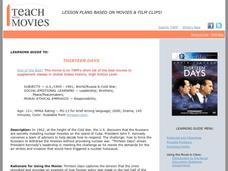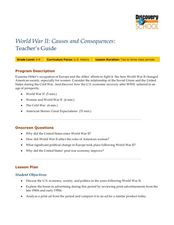Constitutional Rights Foundation
The Cold War: How Did It Start? How Did It End?
What is the difference between a Cold War and a Hot War? Scholars research the beginning of the Cold War. They analyze diary entries as well as excerpts from various events during the 45-year standoff. To finish, they prepare final...
Curated OER
The Early Cold War: 1947-1970
With a combination of images, maps, and valuable information, this presentation is a strong resource for a history class that is coming out of a WWII unit and into a Cold War unit. Some points are outlined for students, while others are...
Smithsonian Institution
Cold War
The Cold War was not necessarily always cold in temperature, but the relationship between the United States and the Soviet Union sure was frigid! Scholars read various passages, view exhibition graphics, and observe an artifact from the...
Curated OER
The Cold War (1945-1991): An Ideological Struggle
Covering the main topics of the Cold War, including some excellent discussion points on the methodologies of the Soviet and Eastern Bloc nations versus the US and Western Democracies, this presentation is a good way to introduce the...
Curated OER
Exploring US Foreign Policy after WWII--The Cold War
Scholars explore U.S. Foreign Policy and Cold War ideologies adopted after WWII. They conduct Internet research on a topic or issue related to the Cold War Era, watch two films, and compose a time line and a multimedia presentation to...
Roy Rosenzweig Center for History and New Media
End of the Cold War
How significant was the Cold War during the 20th century? After reading and analyzing speeches by Ronald Reagan and Mikhail Gorbachev, learners consider the historical context of foreign policy decisions made during the Cold...
Student Handouts
End to the Cold War
Introduce your class to topics relating to the Cold War through a brief reading selection. Class members read the passage and answer four questions, which are provided on the bottom of the page.
Stanford University
Cold War in Guatemala
Students investigate the Cold War and why it was fought in Guatemala. In this Cold War lesson, students analyze documents from the CIA and textbooks then discuss. Students work in pairs to answer questions and fill out graphic organizers.
Curated OER
The Cold War: Chapter 9: Lesson 1
Used as a quick review of the Cold War, Korean War, and Cuban Missile Crisis, this presentation could be in many scenarios. However, the graphics and question types seem more appropriate for younger students, while the content is geared...
Curated OER
The Brief American Pageant: The Cold War Begins
With the beginning of the Cold War came numerous social and political changes around the world - many of which are featured in this series of maps and graphs. This short but informative slideshow will help to bridge the gap between a...
Curated OER
Understanding JFK's Presidency through his Speeches
Students reflect and discuss the major events that happened in the United States in the 1950's and 1960's. In this U.S. History lesson, students read and analyze the famous speeches during this time frame, then complete a worksheet...
Curated OER
The Cold War And Beyond
Students interview an adult that grew up in the United States during the Cold War to develop an understanding of the concept of mutually assured destruction. They focus the interview on how the person dealt with the threat of nuclear...
Curated OER
Vietnam 1945 - 1975 :The 10,000 Day War
Each phase of the Vietnam War is fully developed and defined in terms of political cause and effect and social action. Phase one covers the onset of the war in 1945 through the French defeat at Dienbienphu. Phase two discusses American...
Center for History Education
U.S. Foreign Policy and the Iran-Contra Affair: Was Oliver North a Patriot, a Pawn, or an Outlaw?
If you had to write a song about Oliver North, would it be a ballad or a dirge? If you had to put him on a trading card, would he be a hero or the bad guy? Young historians decide for themselves after examining documents from the...
Curated OER
Cold War
Eleventh graders analyze U.S. foreign policy since World War II, tracing origins and geopolitical consequences (foreign and domestic) of the Cold War and containment policy.
Curated OER
Introduction to the Cold War
Students examine the domino theory. In this cold war lesson plan, students watch a video about dominos and then get into groups that represent different nations. Students will then act out a mock simulation of the containment and domino...
Curated OER
Breaking News English: U.S. Missile Shield
In this U.S. Missile Shield worksheet, students read the article, answer true and false questions, complete synonym matching, complete phrase matching, complete a gap fill, answer short answer questions, answer discussion questions,...
Foreign Policy Research Institute
Categories of Cold War Histiography
While the objective is to provide an overview of the Cold War in preparation for further study, this resource addresses the topic at a rather advanced level, and might need its own introductory lesson. The handouts include terms such as...
Curated OER
Chapters 30 (sections 1 & 5) – The Cold War
For this U.S. history worksheet, students read assigned textbook pages on different topics associated with the Cold War and respond to 50 short answer questions.
Teach with Movies
Learning Guide to Thirteen Days
While Thirteen Days is a fantastic film to use in the classroom in reference to the Cold War and the Cuban missile crisis, it is important to take care to effectively and properly incorporate its contents into your curriculum. This...
Curated OER
Creating a Newscast on the Cold War
Students research the events of a specific year of the Cold War. In this Cold War instructional activity, students investigate the causes of the Cold War and highlight the events of a particular year. Students...
Curated OER
Chapter 21 - The Cold War to 1960
In this U.S. history worksheet, students read assigned textbook pages regarding the Cold War 1950's America and respond to 50 short answer questions.
Curated OER
"Police Action": The Korean War, 1950-1953
Young scholars investigate facts about the war in Korea in the 1950's and attempt to classify American foreign policy as a triumph or a failure. Why the U.S. became involved and the unpopularity of the war in America forms the focus of...
Curated OER
World War II: Causes And Consequences
Students discuss the U.S. economy, society, and politics in the years following World War II. They explore the boom in advertising during this period by reviewing print advertisements from the late 1940s and early 1950s. Students view...



